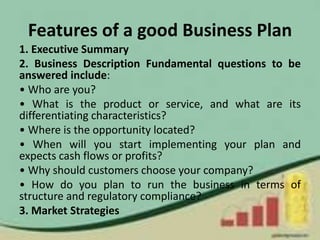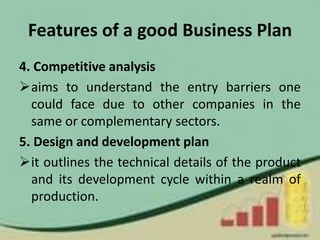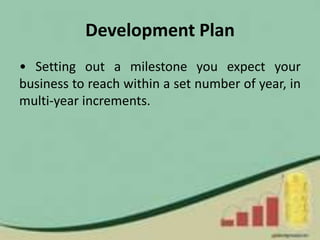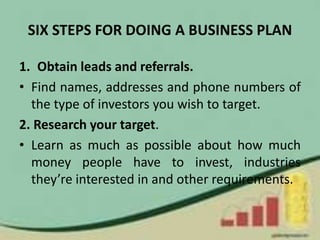Entrepreneur
- 1. BACKGROUND
- 2. Learning Objectives At the end of this chapter, students must be able to; • Understand why and when to develop a business plan • Know how to tell the business plan story • Learn the major sections of the classic business plan • Focus business plan sections to meet specific needs • Identify the major risks to business plan success • Master presenting business plan to others
- 3. What is a Business Plan? • A business plan is a summary document that outlines how and why a new business is being created.
- 4. Why use a Business Plan? • Owing to the following benefits of a well- researched and comprehensive business plan, preparing one is highly recommended, but not a mandate. 1. Feasibility 2. Focusing device 3. Foresight 4. Raising Capital
- 5. Features of a good Business Plan 1. Executive Summary 2. Business Description Fundamental questions to be answered include: • Who are you? • What is the product or service, and what are its differentiating characteristics? • Where is the opportunity located? • When will you start implementing your plan and expects cash flows or profits? • Why should customers choose your company? • How do you plan to run the business in terms of structure and regulatory compliance? 3. Market Strategies
- 6. Features of a good Business Plan 4. Competitive analysis aims to understand the entry barriers one could face due to other companies in the same or complementary sectors. 5. Design and development plan it outlines the technical details of the product and its development cycle within a realm of production.
- 7. Features of a good Business Plan 6. Operation and management plan describe the cycle of business functions needed for survival and growth. It includes management functions such as task, hierarchy, employee recruitment, and operational function such as 7. Financial factors include the company balance sheet and cash flow projections. Financial data is imperative to provide credibility to any assertions or claims made about the future profitability of the business.
- 8. Common Mistakes to Avoid While Writing a Business Plan • The plan must not begin by stressing the superiority of one’s product or service, but instead by identifying a genuine problem faced by the consumer. • A team’s expertise is displayed not by listing their academic achievements and employment history, but by stressing how the team’s experience is best suited for a particular industry sector or product. • The most common mistake is to offer an excessively optimistic view of the opportunity.
- 9. PARTS OF A BUSINESS PLAN • Business plans typically follow a traditional format or structure. They may also include charts and graphs along with a detailed set of financial statements. Executive Summary:
- 10. PARTS OF A BUSINESS PLAN • Highlights the key points of your plan •Answer the general questions about your business concept, team, needs filled, market advantages, financial viability, and overall likelihood of success and profitability.
- 11. Business Description • The basic facts and everyday details of your business • Include the company’s formal name as well as any DBA’s (fictitious business names), and subsidiaries, as well as URLs (domain names) you have secured.
- 12. Market Analysis • You need to know your target audience • Identifies your customers, or how a diverse population of customers breaks down geographically or in other ways.
- 13. Marketing Plan • You should have at least an outline and relatively clear vision of how you will reach your target market and/or sell your product or services. • Be sure that somewhere in your business plan documents you include a realistic budget for advertising, promotion, social media, etc. • Spelling out a plan to promote your business, determine how you wish to be positioned in the marketplace re: corporate values, reputation, slogan, etc.
- 14. Operation and Management Strategy • Operation plan lays out how your business will function to day-to-day and how you will compete in the marketplace.
- 15. Competitive Analysis • Taking into the account of the other business that are competing or will compete, with yours, and their current share of the market.
- 16. Development Plan • Setting out a milestone you expect your business to reach within a set number of year, in multi-year increments.
- 17. Financial Statement • This something you’ll need for your own tax and references, and where you will include statement of how much money you are seeking, from which sources.
- 18. THE PARTS OF THE PLAN • TITLE PAGE The title, or heading, of the plan, and very brief description of the business. The date The name of the owner The company name and location A copyright or confidentiality notice
- 19. THE PARTS OF THE PLAN • TABLE OF CONTENTS A list of the individual sections and their page numbers, starting with the Title Page and ending with a section for Special Materials
- 20. THE PARTS OF THE PLAN • SUMMARY/OVERVIEW A brief, but focused statement (a few sentences or paragraphs) stating why the business will be successful. This is the most important piece of a Business Plan because it brings everything together.
- 21. THE PARTS OF THE PLAN • MARKET ANALYSIS Identifies specific knowledge about the business and its industry, and the market (or customers) it serves. An analysis that identifies and assesses the competition.
- 22. THE PARTS OF THE PLAN • DESCRIPTION OF THE COMPANY A close look at how the different components of the business fit together, such as: o Information about the nature of the business and the factors that should make it successful . To Special business skills and talents that provide the business with a competitive advantage, such as a unique ability to satisfy specific customer needs, special methods of delivering a product or service, and so on.
- 23. THE PARTS OF THE PLAN • ORGANIZATION & MANAGEMENT The company’s organizational and legal structure, Is it a sole proprietorship? A partnership? A corporation? Profiles of the ownership and management team: What is their background, experience and responsibilities?
- 24. THE PARTS OF THE PLAN • MARKETING & SALES The company’s process of identifying and creating a customer base.
- 25. THE PARTS OF THE PLAN • DESCRIPTION OF PRODUCT OR SERVICE A detailed description of the product or service from the customer’s point of view:
- 26. THE PARTS OF THE PLAN • FUNDING The amount of current and future funding needed to start or expand the business. Includes the time period that each amount will cover, the type of funding for each (i.e., equity, debt), and the proposed or requested repayment terms.
- 27. THE PARTS OF THE PLAN • FINANCIALS Explains or projects how the company is expected to perform financially over the next several years. (Sometimes called a “pro-forma projection.”) Because investors and lenders look closely at this projection as a measure of your company’s growth potential, professional input is strongly recommended.
- 28. THE PARTS OF THE PLAN • APPENDIX Provides specific information that certain individuals (such as creditors) may want review. It allows the addition and/or deletion of information as needed, such as:
- 29. SIX STEPS FOR DOING A BUSINESS PLAN 1. Obtain leads and referrals. • Find names, addresses and phone numbers of the type of investors you wish to target. 2. Research your target. • Learn as much as possible about how much money people have to invest, industries they’re interested in and other requirements.
- 30. SIX STEPS FOR DOING A BUSINESS PLAN 3. Make your pitch • First, email or mail an introductory letter to your target letting them know you have a plan you'd like to send. Sending unsolicited, unanticipated business plans with a mere cover letter won't typically get your plan read. • A letter of introduction is your way of asking them if they'd be interested in reading your business plan. You should also explain generally what you’re looking for. • Finally, in the letter of introduction, you may want to detail the terms under which you're presenting your plan. For instance, you may say that you're not submitting the plan to any other investor. Or you may explicitly point out that you're currently seeking financing from a number of sources, including this one. • If you don't hear from them within a week or so, send a follow-up email, and try once more about two weeks later (in case they were out of town or swamped with other work). If this doesn’t produce a meeting, look elsewhere.
- 31. SIX STEPS FOR DOING A BUSINESS PLAN 4. TRY TO MEET PEOPLE IN PERSON • Aside from having mails or calls, you should still try to meet your recipient personally, especially if you're seeking any type of funding. 5.DEFUSE OBJECTIONS • Although you may think you've answered everything in your plan, still prepare a list of possible objections, assumptions and the likes that your investors may raise. 6.GET A COMMITMENT • You won't get an investment unless you ask for it. When all objections have been answered, be ready to offer one last concession “If I give your representative a board seat, can we do this today?” and go for the close.
- 32. Group 7 Marina Rosario Winnie Rose Rosario Ericka Ashlyn Rulloda Mary Rose Sanchez Rosalyn Serrano Marjorie Tamayo Maureen Joyce Ursua Anjeanette Verceles Arvie Verzosa Kharen Joy Vinoya































